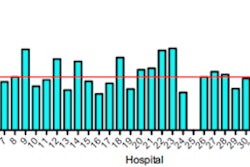
AuntMinnie.com is pleased to present the first installment of Leaders in Imaging, a series of articles profiling the individuals who are shaping the radiology landscape. Our first interview is with Dr. Leonard Berlin, vice chair of radiology at NorthShore University HealthSystem, Skokie Hospital, in Skokie, IL. Dr. Berlin is a frequent speaker on medical malpractice topics and other legal issues in radiology.
AuntMinnie: You spoke at the RSNA conference last year about the importance of radiologists communicating findings proactively to avoid malpractice litigation. Do you think that radiologists are getting the message?
Berlin: They are. We had a mock trial at this past RSNA meeting, using a failed radiology communication case as the example. There were about 300 attendees, and they filled out a questionnaire, answering a couple true-false questions.
The first question was: "True or false? Virtually all appeals court decisions in the U.S. have held that radiologists have a duty to directly communicate radiologic findings to referring physicians." Ninety-two percent of the attendee respondents said this was true. Three or four years ago, it probably would have been 50%, and 10 years ago, less than 10%.
The second statement was: "If a radiologist reports a significant abnormality and transmits that finding to the referring physician, but later the referring physician says he never got the report, the radiologist would still be found guilty for failing to communicate." Eighty percent said yes.
The bottom line is that the word is getting out. In fact, now the language in the American College of Radiology's [ACR] communication guideline says that radiologists have to transmit significant unexpected findings in "a manner that ensures receipt."
Have you seen any change in the malpractice situation within radiology?
Nationally speaking, the number of malpractice lawsuits has decreased in every state in recent years, although the median jury award of about $1 million hasn't changed.
What's your opinion on tort reform?
Some states are tackling tort reform, and I'm not against it, but I don't think it's going to change anything. Even if tort reform is adopted, the practice of defensive medicine has become the standard of care in the past 10 to 20 years. Even if malpractice wasn't an issue, physicians would still order the CT scan for the patient that comes into the ER with a headache.
 |
| Dr. Leonard Berlin, vice chair of radiology at NorthShore University HealthSystem. |
Information technology is very important. If we have an electronic report and we have evidence that the report was opened, that's documentation that the referring physician at least saw it and that the results have been transmitted in "a manner that ensures receipt," to go back to the ACR communication statement. Some PACS can do this.
If we look back at the past decade, radiology has made technology advances in equipment, but it's still way behind on technology advances in communication. We can image anything and everything, but the way we communicate results is just beginning to change.
As radiologists and hospitals have more experience with malpractice suit settlements, however -- which tend to be about $1 million, $2 million -- it's becoming clear that hiring staff or installing technology to better communicate findings would be a better use of that money.
You've also recommended that outpatient results be given directly to patients. Do you think that radiologists are prepared to assume a more active role in interacting directly with patients? If not, what should they do?
The Mammography Quality Standards Act [MQSA] took effect in 1999, and it mandated that mammography reports be sent directly to patients. Just that one change has addressed many communication problems in mammography, and although there are certainly still mammography malpractice suits, they don't tend to be about failed communication. Traditionally, the model has been that the doctor doesn't tell the patient test results. But patients want information and they should have it.
Traditionally, radiologists have been the "doctors' doctor"; we talk to the referring physician, and that physician talks to the patient. But things are changing, in part because patients are demanding more information. Radiologists are slowly beginning to interact directly with patients. We're not quite there yet -- radiologists just don't tend to be used to this direct contact.
How do you think the recent debate over mammography screening sorted out? Do you think fallout from the debate will hurt mammography in the long term as fewer women get screened?
I just published with my colleague Dr. Ferris Hall an article in Radiology about the "mammography muddle" [May 2010, Vol. 255:2, pp. 311-316]. We got maybe five e-mails commending us, but other than that, utter silence.
Mammography volume is down, and there are a lot of reasons for that, including our country's economics, so to blame it all on the U.S. Preventive Services Task Force isn't fair. I think the public is so oversold on mammography, it's such a political hot potato, that even if volume is down now it will go right back to where it was. I'm certainly not antimammography. But it is worth looking into the issue of overdiagnosis.
Do you see any technologies on the horizon that may enable mammography screening to be used with more precision, such as by targeting women at high genetic risk?
Molecular imaging, definitely. There's lots of talk about it, and it's not quite ready for the market, but it's going to be the answer. We just need better screening. Thirty percent of all cancers found in screening mammography are ductal carcinoma in situ [DCIS]; at worst, 30% to 40% of those DCIS cancers go on to become invasive cancer. But we don’t know when we find DCIS whether it will become invasive or not, and because we can't differentiate, everyone is treated as if it will. One day -- maybe in five, 10 years -- we'll be able to tell the difference. We'll be able to tell women, "yes, you have histological cancer, but it's not going to kill you."
What do you think of the rise of teleradiology? Is this radiology's future?
Teleradiology is a big issue, and it's changing everything. The business model is the biggest threat right now to radiologists. Not radiology -- there will always be a need for imaging -- but radiologists as specialists who read scans. The movement toward teleradiology makes us into a commodity. And readers will be all over the world.
Right now, final reads have to be rendered in the U.S., but what happens if that law changes? We're already getting preliminary reads overseas. Radiologists opened the door ourselves when we accepted nighthawk services. It seemed like a great idea to farm out the night reads, but now the great idea is coming back to haunt us.
What do traditional radiology groups need to do to compete in an era of national groups and full-service teleradiology coverage?
You hear the platitudes: offer better service, etcetera. But I'm not optimistic [that there's much to do to counter the trend]. I hope I'm wrong.
Dr. Leonard Berlin has been a professor of radiology at Rush Medical College in Chicago for more than 23 years. He was awarded gold medals for distinguished service to radiology by the American Roentgen Ray Society (ARRS) in 2002 and the Chicago Radiological Society in 2005. Berlin currently serves as the chair of the ACR's task force on conflict of interest and as co-chair of the RSNA/ACR task force to develop a core curriculum on professionalism for radiology residents.
By Kate Madden Yee
AuntMinnie.com staff writer
May 25, 2010
Related Reading
Communication failure: A surefire route to malpractice court, February 16, 2010
Copyright © 2010 AuntMinnie.com



















